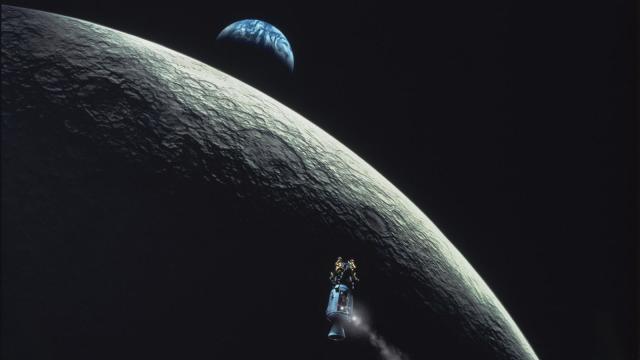When mission commander James A. Lovell uttered his gut-wrenching warning, “Houston, we have a problem,” neither he nor the army of NASA engineers back on Earth really knew if his crew would — or even could — make it back home.
In the 72 hours that followed Apollo 13’s disastrous oxygen tank explosion, NASA engineers worked feverishly to find any way to somehow limp the damaged command module 200,000 miles back to Earth. But first, they had to devise a means of keeping the crew from killing themselves with their own breath.
Turning off the lights
At 80:00 GET the situation with consumables looked bleak. The PC+2 burn ensured that the Command Module would be on the water at 142:40 GET. But as it stood, 30 minutes after the hurry-up burn, the water supply was running at 4.8lb/hr, with depletion projected at 126:06 GET. The oxygen consumption rate was down and would stretch to 253:00 GET, but at current levels of consumption at 37Ah the battery power would be gone by 120:48 GET. Unresolved but being worked on, the lithium hydroxide canisters from Odyssey would somehow have to be strapped on to the hoses for Aquarius to reduce carbon dioxide levels.
At no time since the crew powered up Aquarius at 58:40 GET had the consumption of electrical power dropped below 24.9Ah. The use of LM systems, especially the PGNCS and other guidance and navigation equipment, had taken its toll, reaching 37.6Ah during PC+2. Now, in the subsequent power-down, use would have to fall to 10 — 12Ah. Because of the link between electrical power and water consumption for the cooling system, reduced power levels would lower temperatures and cut water consumption from 4.8lb/hr (2.18kg/hr) to 2.5lb/hr (1.13kg/hr), taking it out to 150:00 GET.
As things stood at this point, Aquarius would have to be powered up about 35 — 40Ah around 134:00 GET to top up the Odyssey’s Command Module batteries for re-entry after Aquarius was cut loose, and for supplying power to the CM, getting it ready to support the crew when it was finally on its own shortly before entering the atmosphere. In summary, the moderate power levels since first getting into Aquarius, and the high power levels of the two engine burns, would be followed now by a very deep cut in electrical use for the next 52 hours before finally turning on the systems again prior to re-entry. At NASA facilities and among the host of contractors and subcontractors now working across the country to solve myriad minor issues regarding the consumables, a team at the Windsor Locks facility of Hamilton Standard were fathoming out whether they could use the 14.5 hours of water remaining in the Command Module to supplement the supply in Aquarius. The problem was that the water in Odyssey was chlorinated and that in Aquarius‘ environmental control system was not. Could the chlorinated water be used in the LM’s sublimator? Tests showed that it could.

Then Hamilton Standard’s backpack manager Cal Beggs worked up a method whereby the crew could transfer this chlorinated water from Odyssey into the supply in Aquarius. The Personal Life Support System or PLSS (pronounced ‘pliss’) backpacks were precharged with six hours of water supply for the Moonwalks. A team including James Morancey worked up a procedure whereby the PLSS water could be fed into the main supply in Aquarius, reversing the normal procedure for refilling each PLSS for a second Moonwalk. Then they found a way to use the empty tanks to ferry water from Odyssey, but with water consumption slashed these back-up techniques were not needed, although the engineers even considered using urine to keep the coolant system going!
Aboard Aquarius and in conjunction with ground operations, power-down began within five minutes of the end of the PC+2 burn, and at 79:52 GET the ground read up a fairly complex procedure for setting up a passive thermal control mode. But problems with stabilising the barbecue roll persisted for more than an hour until finally resolved. During this period the crew reported seeing sizeable chunks of debris floating alongside the spacecraft, possibly material loosened from the crippled Service Module by the vibrations of the PC+2 burn.
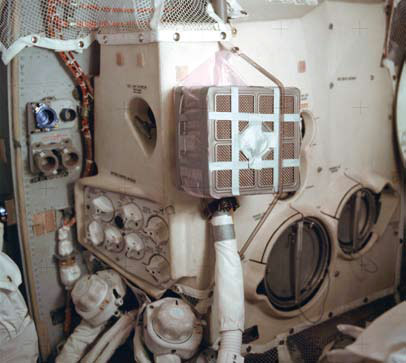
As Mission Control eventually knew it would, the CO2 level reached 7.5mmHg at 80:30 GET, triggering a master alarm, a level set pre-flight to advise the crew to change the LiOH canister. But the medical team advised the crew that it could safely run up to a concentration of 15mmHg without any noticeable effect and that when it reached that level in about five hours they should change the primary canister for the secondary. After that the special procedure for using Odyssey’s canisters could be implemented. In tests a level of 22mmHg could be tolerated, but nobody wanted to go that high.
As related earlier, there were not enough round-shaped canisters to last, and the more prolific square-shaped cartridges in Odyssey would have to be used in Aquarius — somehow! By late Tuesday, 14 April, as Lovell and Swigert were shortly to begin their sleep period, Beggs and around 100 people at Hamilton Standard had been working on a solution and kept up an intensive dialogue with the NASA people in Mission Control to get it validated.
The original idea to construct a makeshift adaptor allowing the canisters from Odyssey to operate in Aquarius had been born in the mind of a NASA engineer who had lived and worked with the LM Environmental Control System (ECS) for several years. As chief of the Crew Systems Division, Ed Smylie, together with his assistant Jim Correale, had been responsible for managing the design of all equipment related to crew activity, and from within hours of the news about the accident he had concocted a way of keeping the atmosphere clean. Working with the environmental test chamber in
Building 7, Smylie and Correale had duplicate LiOH canisters flown from Cape Canaveral to Houston, and by late afternoon on 14 April they had rigged up the test run in Building 7 and demonstrated that the system worked.
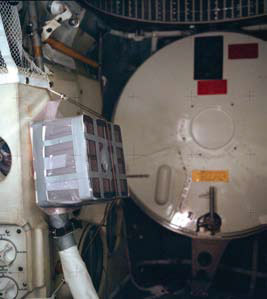
The crew would use tape and stiff card, together with plastic bags and ingenuity, to stack the square canisters from Odyssey and attach them to hoses leading from the ECS in Aquarius on connections normally used to hook up the astronauts’ space suits. In this juryrigged concept, contaminated oxygen would be drawn into the square cartridges and scrubbed of CO2 before circulating back into the LM ECS and fed out via a hose attached to the outlet that would normally be used to clean oxygen from the suit.
In this rather complex system of boxes, hoses and pipes, the LiOH canister receptacle would be bypassed, the oxygen scrubbed of contaminating carbon dioxide outside, rather than inside, the ECS. A second inlet-outlet arrangement would be set up in Odyssey by stretching hoses through the tunnel from Aquarius. At least, that was the idea. Smylie brought his ‘mailbox’, as it became known, up to Mission Control to show the flight controllers what was needed. It would now have to be built by the crew from sundry items found around Aquarius and Odyssey, but not just yet.
At 80:37 GET (9:50pm in Houston), Vance Brand read up to the crew the basic idea and what was needed, in notably non-technical language: ‘We have a lengthy procedure here, but in short you use plastic as a covering for the whole thing. You put some kind of stiffener against the LiOH entrance side. You need grey tape to stick the whole thing together and you need something like a sock to put in the bottom so that the outlet side is plugged up. As it turns out the flow is rather U-shaped through the cartridge…If you plug up the bottom it comes in one side of the top and goes out the other.’
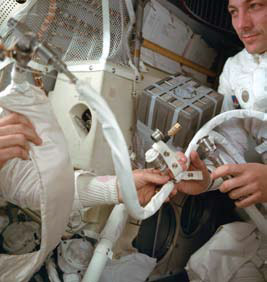
Within 45 minutes Brand suggested the crew get something to eat before Lovell and Swigert began a rest period at around 82:00 GET, current power levels now coming down toward 12A, which would be achieved within three hours, lower than anything seen since the accident. A simple calculation (P[W]=I[A]xV[v]) shows that with a 28V DC current from the LM batteries, a 12Ah power usage produces around 336W. Such was the level of power running Aquarius — less than the power from four ceiling light bulbs in the average home; one third of the power needed to run a one-bar electric heater or a toaster!
At 81:46 GET, Brand read up a report that trajectory analysis after the PC+2 burn indicated a need for a further midcourse burn of 4 — 6ft/sec (1.22 — 1.83m/sec) using the descent engine, and gave Lovell a detailed rundown on the consumables status — what remained, how deep the power-down had to be and how long each of the prime assets would last. After that review it was time for Gene Kranz to step down, relinquish the console to Milt Windler and his Maroon Team and get back to Room 210. That got under way at 82:00 GET — 11:13pm in Houston.
Before the shift change, Brand passed up a further message: ‘Deke [Slayton] says get a night’s sleep. He says you’ve been working hard and you ought to relax a little bit and be ready for tomorrow.’ It was coming up on midnight, a new day about to dawn — Wednesday 15 April. By midnight Swigert was finishing up a meal and Haise was completing final power-down steps, while Lovell was already up in Odyssey preparing his bunk for the night.
On the stroke of midnight Houston time, Haise got on to Jack Lousma at the Capcom console: ‘OK, when I was upstairs [in Odyssey] just a minute ago I noticed what appeared to be some new venting from down the Service Module way. I noticed that out window 1, and also saw one chink of metal — loose metal about four inches [10cm] square that was tumbling around — silver in colour and it looked like it had come from somewhere down in the Service Module…I’m looking out the LM window now and I see a good part of the new star field it’s created for us. There are about a thousand little sparklies out here.’
At 12:35am, Gene Kranz, astronaut Anthony England, INCO William Peters and CONTROL (control officer) Richard Thorsen hosted a press conference in the main auditorium in Building 1, chaired by public affairs officer John McLeaish. From the outset, the press had been invited into all activity, and two pool correspondents were allowed to sit in the MOCR and observe what was actually going on, reporting what they saw.
The first 24 hours after the accident had been focused on getting Apollo 13 back on a free-return trajectory, rounding the Moon and speeding up to cut the trans-Earth time by 10 hours. The second 24 hours would be spent powered down to the absolute minimum, rigging up the makeshift ‘mailbox’ for keeping down CO2 levels. The third 24 hours would be committed to refining the trajectory with a course correction and getting the procedures ready to power up the Command Module for re-entry.
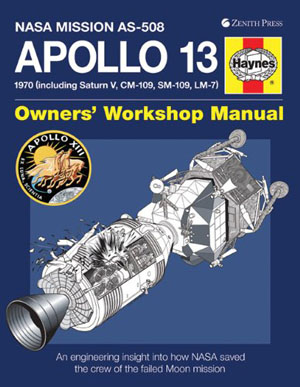
Excerpted with permission from Apollo 13 Owners’ Workshop Manual: An insight into the development, events and legacy of NASA’s ‘successful failure’ which is available on Amazon.
